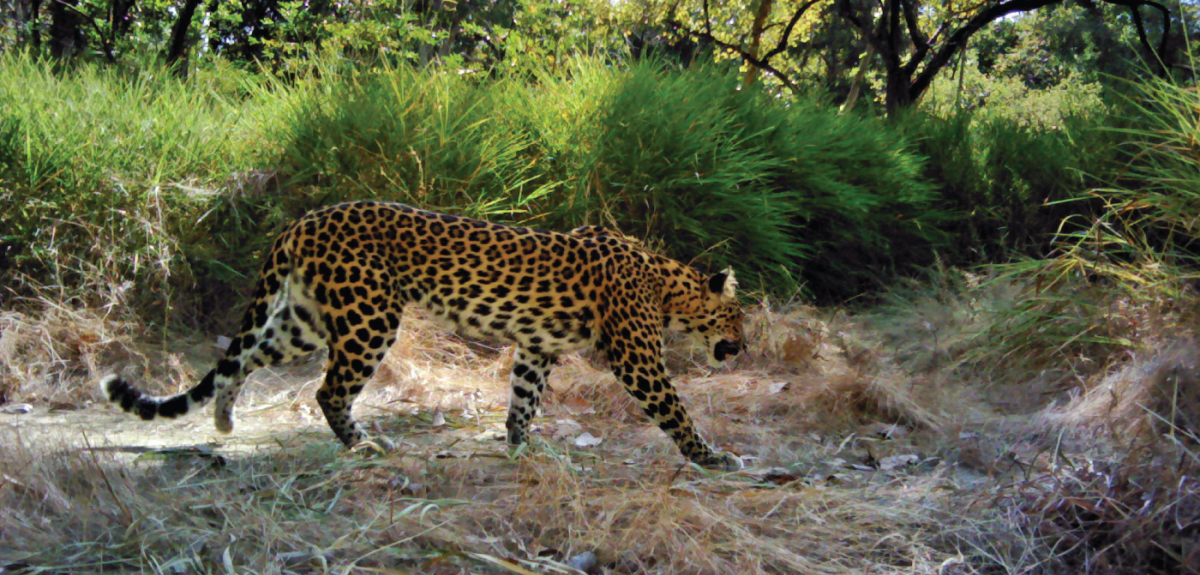
Image credit: Panthera / WildCRU / WWF Cambodia / FA
New study confirms Cambodia's last leopards on brink of extinction
A new study has confirmed that the world's last breeding population of leopards in Cambodia is at immediate risk of extinction, having declined by 72% during a five-year period. The population represents the last remaining leopards in all of eastern Indochina – a region incorporating Cambodia, Laos and Vietnam.
The report is published in the Royal Society Open Science journal by Oxford University's Wildlife Conservation Research Unit (WildCRU), Panthera – the global wild cat conservation organization – WWF-Cambodia, the American Museum of Natural History, and the Forestry Administration of the Ministry of Agriculture, Forestry and Fisheries of Cambodia.
Carried out in Cambodia's Eastern Plains Landscape, the study revealed one of the lowest concentrations of leopards ever reported in Asia, with a density of one individual per 100 square kilometres. Increased poaching, especially indiscriminate snaring for the illegal wildlife trade and bushmeat, is to blame for the dramatic decline, according to the researchers.
Panthera Southeast Asia Leopard Program Coordinator and study co-author Dr Jan Kamler said: 'This population represents the last glimmer of hope for leopards in all of Laos, Cambodia, and Vietnam – a subspecies on the verge of blinking out. No longer can we, as an international community, overlook conservation of this unique wild cat.
'As the world gathers to celebrate World Wildlife Day this Saturday, we must band together in action, not just in words, to curb the epidemic of poaching facing this gorgeous big cat and others around the globe.'
Professor David Macdonald, Director of WildCRU in Oxford's Department of Zoology and a co-author of the study, said: 'Leopards are a monument to opportunism, adapting to habitats from desert to urban jungle, but their adaptability risks a deadly complacency: people think "oh, leopards will be fine". They won't. Almost everywhere they are doing worse than people thought, and our findings show that in Southeast Asia they are heading for catastrophe.'
In addition, scientists discovered that the primary prey of leopards was banteng – a wild species of cattle weighing up to 800kg. In particular, male leopards targeted this large mammal, making this the only known leopard population in the world whose main prey weighs more than 500kg, more than five times the leopard's mass. Scientists believe the Indochinese leopards' new choice of prey was triggered by the local extinction of tigers from the region in 2009, which created a predatory void for the opportunistic and highly adaptable species.
Prompted by the study's findings, Panthera and WildCRU are working with local and national collaborators to increase effective law enforcement and monitoring of this region, which will include the use of Panthera PoacherCams, and to strengthen environmental laws to develop strictly protected conservation zones and increased fines for poachers.
Historically found throughout all of Southeast Asia, the Indochinese leopard has lost 95% of its range and is likely to be classified as critically endangered later this year. Poaching for bushmeat and the illegal wildlife trade, habitat loss, prey decline due to bushmeat poaching, and conflict with people are to blame for the situation, creating a deadly cocktail of threats facing leopards in Asia and around the globe.
WildCRU scientist and lead author Susana Rostro-Garcia said: 'Much of the snaring in Cambodia, and across Southeast Asia, is driven by the rising demand for bushmeat. Wild landscapes are covered with thousands of snares set to catch wild pig and deer to supply bushmeat markets. Unfortunately, these snares also negatively impact many other species, with leopards and other wildlife often caught as by-catch, and their valuable parts removed and sold to illegal wildlife traders.'
 Expert Comment: Why cherish the analogue in a digital age?
Expert Comment: Why cherish the analogue in a digital age?
 New Year Honours 2026
New Year Honours 2026
 New study estimates NHS England spends 3% of its primary and secondary care budget on the health impacts of temperature
New study estimates NHS England spends 3% of its primary and secondary care budget on the health impacts of temperature
 International collaboration launches largest-ever therapeutics trial for patients hospitalised with dengue
International collaboration launches largest-ever therapeutics trial for patients hospitalised with dengue